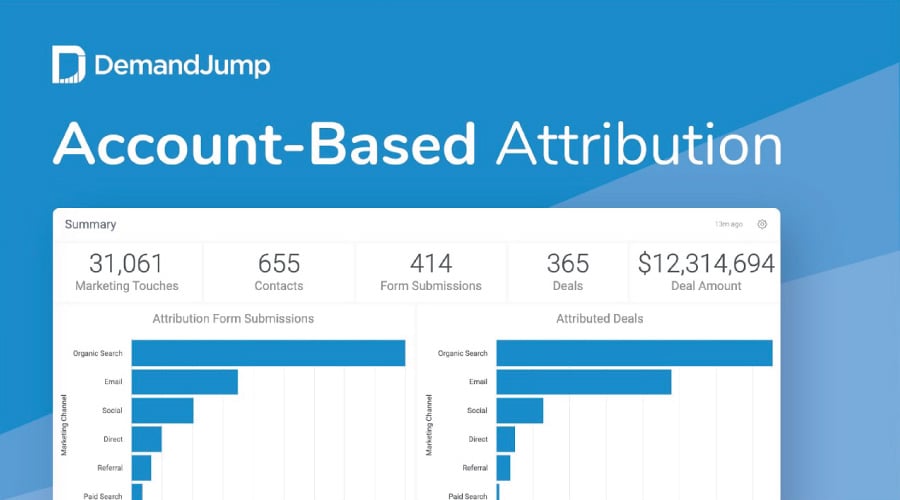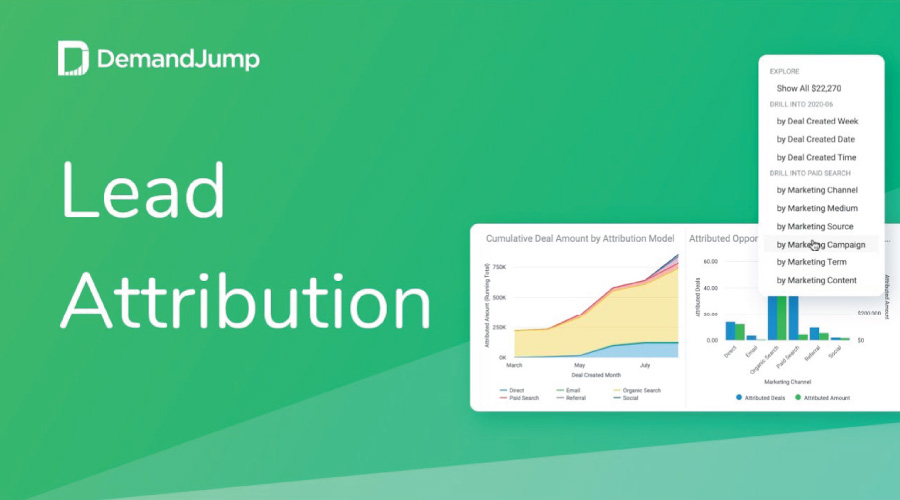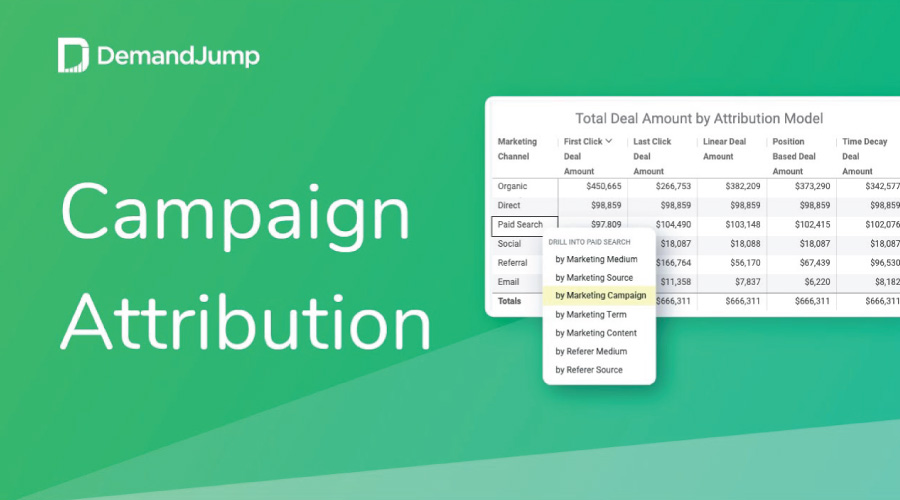Marketing Attribution
By embracing DemandJumps approach to SEO, we have been able to increase our organic rankings within just 2 weeks of implementing recommendations. This helped us see a 22% increase in organic search month-over-month.
Robert Jacko Vice President Digital Marketing @ Homage
DemandJump has become a crucial extension of our marketing team, providing game changing insights to fuel and propel all aspects of our digital marketing efforts. The DemandJump platform is a must have, we are seriously impressed.
Tim Lavinder Director of Ecommerce @ Hotsox
We used to spend hours looking for insights in dozens of tools and reports. Now we log into one place to find out what customers are doing and how to meet them where it matters most.
Zach Roop Digital Marketing Manager @ Dometic
We use DemandJump recommendations as our digital to-do list. We love going in and seeing the recommendations and knowing what to do next.
JoLynda Wilson Marketing Director @ IWC
Our Customers Love Attribution






Account-Based Attribution
Eliminate wasted time and spend. With DemandJump's automated account-based attribution
solution you will know with certainty which efforts are driving ROI.
Measure Your Marketing Performance
Find out which of your marketing efforts are making the biggest impact. See which channel drove consumers to you, the pages they visited, and all touchpoints along their path to purchase.
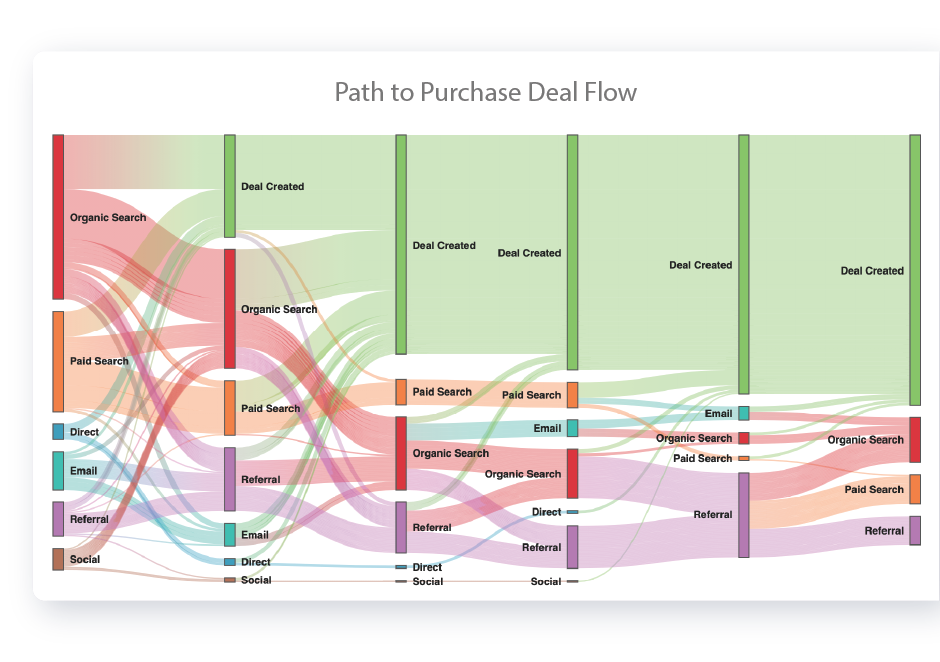
From Marketing Spend to Actual Pipeline Value
When a lead becomes a customer, you need to know which marketing channel or campaign should receive credit, and account-based attribution will give you the answers.
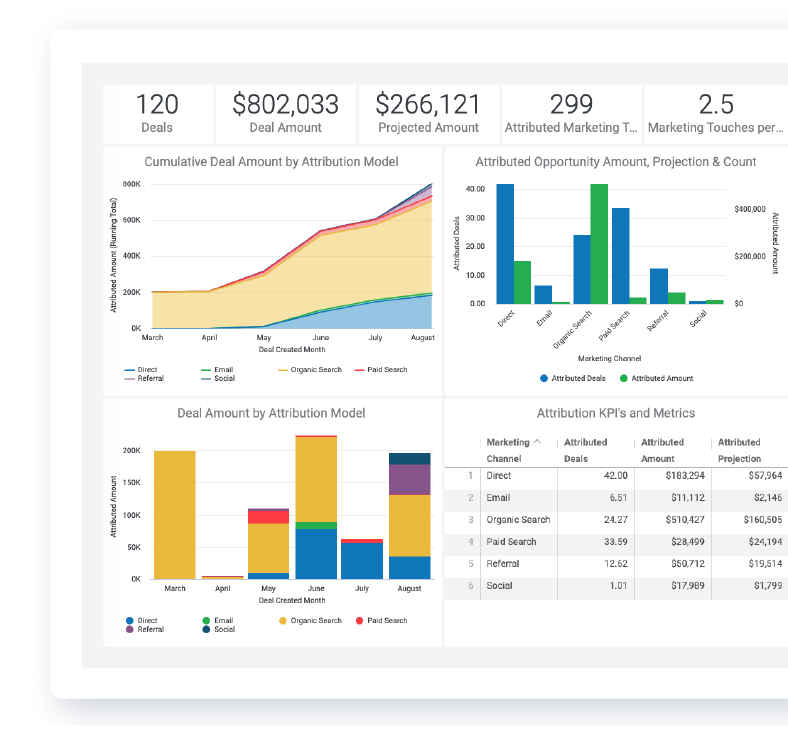
Organic & Paid Search Keyword Attribution
Beyond channel, campaign, and content attribution, you will finally see which organic and paid keywords are generating deal and opportunity revenue.
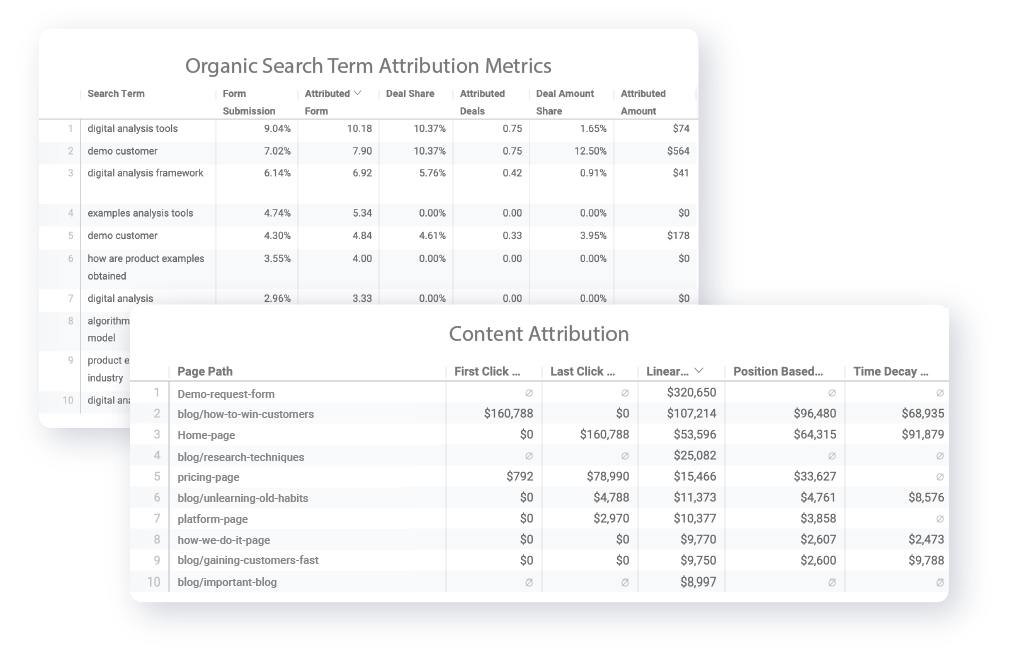
See a Demo of Attribution
What is B2B Marketing Attribution?
At its core, marketing attribution is an opportunity for marketers everywhere to use analytics to figure out exactly which of their current marketing tactics are contributing to sales or conversions. Likewise, the right marketing attribution model is a viable way to gain better visibility over all of your efforts, taking a closer look at what is working and (more importantly) what is not so that you can make the most informed decisions possible moving forward.
In a more granular sense, B2B marketing attribution is about taking a look at every touch point that a customer goes through on their buyer's journey to see which channels and techniques had the greatest impact, all so that marketers can gain a better understanding of what they need to do to create that same experience for as many people as possible.
The level of insight provided by any data driven attribution model specifies not only how someone was exposed to your messaging, but where and even when. It lets you see exactly what someone did in terms of interacting with your brand messaging, which can uncover certain trends and patterns that otherwise would have gone undiscovered had you not been paying attention. All of this is in service of what is ultimately the most important goal of all: allowing marketing teams to better customize campaigns to meet the needs of individual prospects, significantly improving marketing return on investment across the board.
What are the Benefits of B2B Marketing Attribution?
When executed properly, revenue attribution models can help marketers accomplish a number of important goals, all at the same time. Chief among these involves the opportunity to optimize marketing spend across the board. If you know exactly which of your touch points are currently earning the most engagement, you can adjust your budget accordingly to support these channels as much as possible. This is the type of insight you simply would not have access to without some type of user attribution model.
This bleeds directly into another one of the most important benefits that a data driven attribution model brings with it: dramatically improved return on investment. If you know the exact steps required to reach your ideal customer (and which steps are ultimately ineffective), you can double down on the former and get rid of the latter as much as possible. Not only will this lead to increased conversions, but it will earn you a higher marketing ROI as well.
From the perspective of the users themselves, marketing and media attribution also creates a much more personalized experience for them in the future. If you as a marketer are using a data driven attribution model to better understand the preferences of each individual customer, you are more effective at targeting them with the right content at exactly the right moment in their journey. Customers get to feel like you are always on the same page with them as a brand, which breeds a tremendous amount of trust and loyalty and creates for a far better experience overall. Not only is this a way to get better at marketing - it can also become a genuine competitive advantage for your brand, too.
Learning how to measure marketing attribution can also have a positive impact elsewhere in your business, too. Keep in mind that user attribution allows marketers to better understand what their customers need, and that extends a great deal beyond simple advertising collateral. These insights can absolutely play an invaluable role when making updates to products you have already released or when launching new services to the market. In that case, you are putting yourself in a better position to understand the functionality that customers truly want - thus leading to improved product development capabilities as well.
What are the Different B2B Marketing Attribution Model Options?
Overall, there are a few different B2B attribution models (same as B2C models) that you can choose from depending on your needs. Just a few of these include but are not limited to ones like:
- >Multi touch attribution. As the name suggests, multi touch attribution allows you to monitor both online and offline interactions with prospects using the same set of attribution tools. This takes a look at not only social media, PPC and related marketing channels, but also offline techniques like direct mail or print advertising as well.
- A first touch attribution model. This is a form of single touch attribution model that attributes conversion to just a single moment in the customer's journey - in this case, the first time they interacted with your brand. While this certainly lacks the ability to give you a nuanced look at the entire journey, if nothing else it could be a viable way to properly determine your primary campaign source.
- A last click attribution model. Unlike the first touch attribution model, this attributes conversion to the last piece of marketing that someone engaged with before deciding to make a purchase. Again - it does not necessarily give you a chance to truly see "the bigger picture" like a multi touch attribution model could, but it is an opportunity to see where the majority of your revenue happens to be coming from.
Ultimately, the question of which user attribution model to use will come down to your specific goals as a marketer. If you are not currently conducting any type of extensive multi touch campaign, a multi touch attribution model may not necessarily make sense. Likewise, which attribution model to use will be heavily impacted on your primary campaign source, among other factors.
All of this is to say that there is not necessarily a "one size fits all" approach to selecting a user attribution model. You should not expect to begin with the model and work your way to the insight you seek. Instead, you need to start with both your audience and the goals you are trying to accomplish. Once you understand as much about those two ideas as possible, you can work your way backwards and determine which model is best suited to your own individual needs.
Regardless, the revenue attribution models you select should give you answers to questions like:
- Which messages are customers seeing most frequently, and where are they seeing them?
- Which touch points had the biggest impact on their decision to make a purchase?
- What role did brand perception play in that purchase?
- Was the precise sequence of messages important?
- Which messages had the best response from each prospect?
How Do You Measure B2B Marketing Attribution?
As stated, so much of your efforts in terms of how to measure marketing attribution will be directly impacted by which attribution model you select in the first place. Multi touch attribution obviously requires an entirely different process than a single touch attribution like the last click attribution model. Here, you are trying to understand what critical piece of content was finally able to convert that interested prospect into a paying customer at the bottom of the sales funnel. This is by far the most straightforward way to measure marketing attribution and you can likely do so using the data you are already creating if you are measuring the effectiveness of your campaigns at all.
If all of your sales are being generated via your website or a specific landing page, all you would need to do is use attribution technology to determine which page ended up sending users to those locations. Look at all sources and determine which one drove the most volume to figure out what your biggest campaign source turned out to be.
More than likely, you will want to use a custom marketing attribution model to get the most out of your data. Rather than giving 100% of the credit for a purchase to the content at the beginning or end of the funnel, this allows you to attribute different percentages of credit based on which analytics are most crucial in your eyes. If you already know that a particular eBook that you published drove a significant number of conversions, for example, you can and should assign it more value in the custom media attribution model you are building.
This process is usually employed by marketers who already have some level of understanding of the value they are offering at all points across the buyer's journey. You know that your eBook, your webinar, your website and your video interview series are generating significant purchase activity. Now, you want to dive deeper and determine which ones are the most effective for specific types of people.
The benefit of this approach is that it allows you to build an attribution model that is custom designed to not only the unique content you are creating, but the precise customer journey you are offering, too. In the end, you are left with a model that really only makes sense within the context of your business - which is exactly how things should be. But again - which attribution model to use is a decision that you and you alone can make.
What is a B2B Marketing Attribution Tool?
Marketing attribution software is a piece of technology designed to not only bring data from all of your marketing channels together, but to do so in a way that visualizes everything and makes it easy for anyone in your organization to understand. In essence, in combines all information from not only the digital ads you are purchasing but also your social media activity, your website and more and condenses it all into a single dashboard that allows you to get a true bird's eye view of your current successes and those efforts that really are not paying off in the way you thought they would.
If all of this sounds complicated, the good news is that there is truly no shortage of marketing attribution software for you to choose from to help you on your own journey. DemandJump’s attribution technology is available for a 7 day free trial. Fill out the form on the page and give it a try for yourself, no credit card required, no obligation.
What is Campaign Influence in B2B Marketing?
Finally, it is important to better understand the topic of campaign influence - a chance to measure and track how multiple B2B campaigns may have influenced a single purchasing decision. It is a concept that is particularly relevant to Salesforce users in particular, although the lessons learned here apply to other software, too.
In other words, campaign influence and campaign opportunity relationship are all about diving deeper into the amount of revenue being generated by a specific initiative. So you do not just know which techniques are driving the most sales. You also know exactly how much revenue you are getting versus what you are putting into the campaign by way of your budget. You can also separate activity into marketing sourced deals versus other lead sources and more.
A big part of this in Salesforce in particular has to do with the Campaign Influence Related List - something that shows all campaigns that have touched a particular opportunity. In this context, an opportunity is a purchase in progress. You can use data to track which accounts the deals are in reference to, who the major players are, the amount of potential sales you are talking about and more.
By understanding which campaigns have touched a particular opportunity by way of the Campaign Influence Related List, you suddenly know how your efforts are performing both individually and as a larger, more cohesive whole. You can see how everything fits together and which parts of the chain may be weaker than the others, allowing you to bring your various channels together to form something far more powerful than any one of them could be on their own.
Campaign Opportunity Relationship builds on this idea, because even though an opportunity will usually only have one primary campaign it may have been influenced by many across the entirety of the buyer's journey. This is particularly helpful if you are looking for more information about what role your eBooks, your case studies and even your email newsletters may have had in an opportunity, even though you may already know that your primary driver was something else entirely.
In the end, B2B marketing attribution, campaign influence and all other concepts are about one idea above all others: context. You do not just need to know that you are meeting your revenue goals to create a better and stronger business in the future. You need to know where that revenue is coming from. You need to know which of your activities are generating the most paying customers. You need to know where you are potentially losing a significant number of deals so that you can get rid of these liabilities as quickly as you can.
This context is critical in the business-to-business space because your success is built on nothing if not the quality of the relationships you are able to forge. B2B marketing attribution is all about creating stronger, longer lasting relationships that are mutually beneficial for everyone involved - which is why this is one topic that is absolutely worth paying attention to as you continue to develop your campaigns moving forward.
Marketing Attribution Resources
Marketing AttributionAttribution Tracking
B2B Marketing Attribution
Hubspot Attribution
Marketing Campaign Influence
Mobile Attribution
Multi Touch Attribution
Offline Attribution
Sales Forecasting
Sales Opportunity Attribution
The Future of Data-Driven Marketing
Opportunities of Internet Marketing
Other Resources
Channel Optimization
Consumer Behavior
Consumer Insights
Consumer Insights and Analytics
Competitor Analysis Tools
Content Marketing
Content Strategy
Cross-Channel Analytics
Customer Insight Research Techniques
Customer Journey Map
Market Intelligence
Marketing Analytics Techniques
Market Research
Marketing Attribution
Opportunities of Internet Marketing
Types of Consumer Insights



